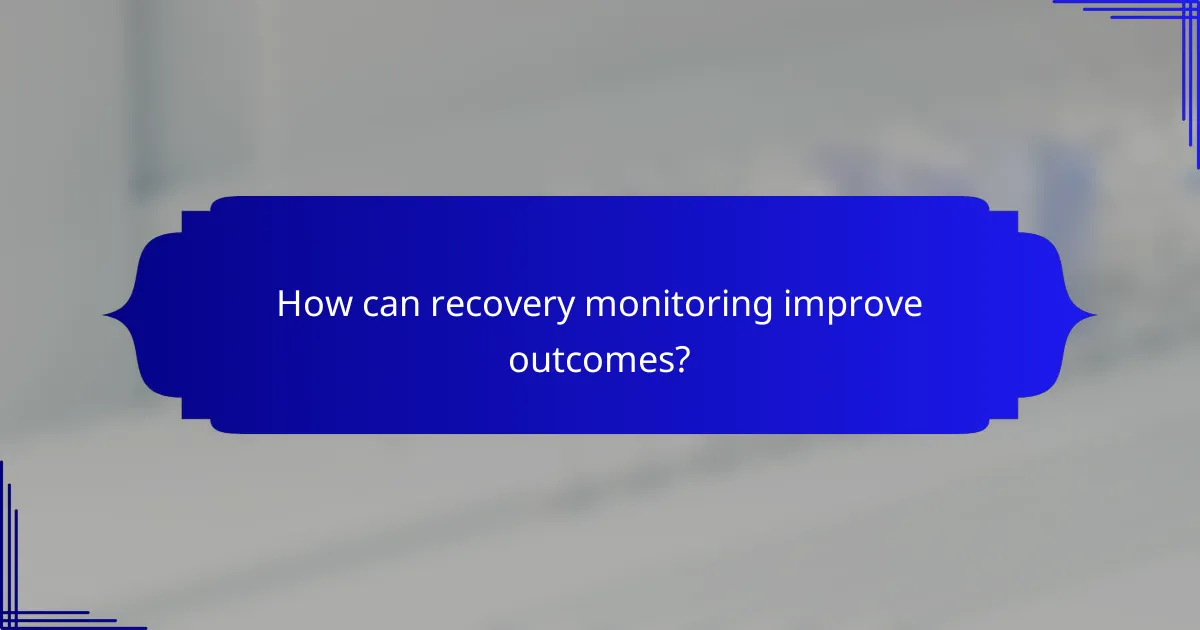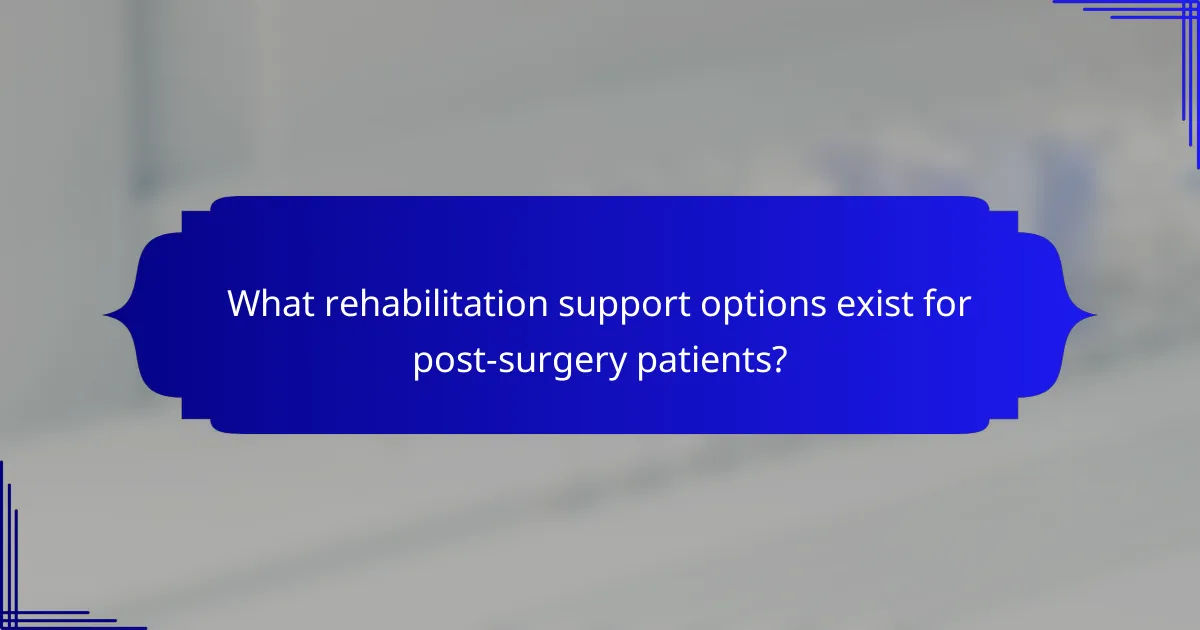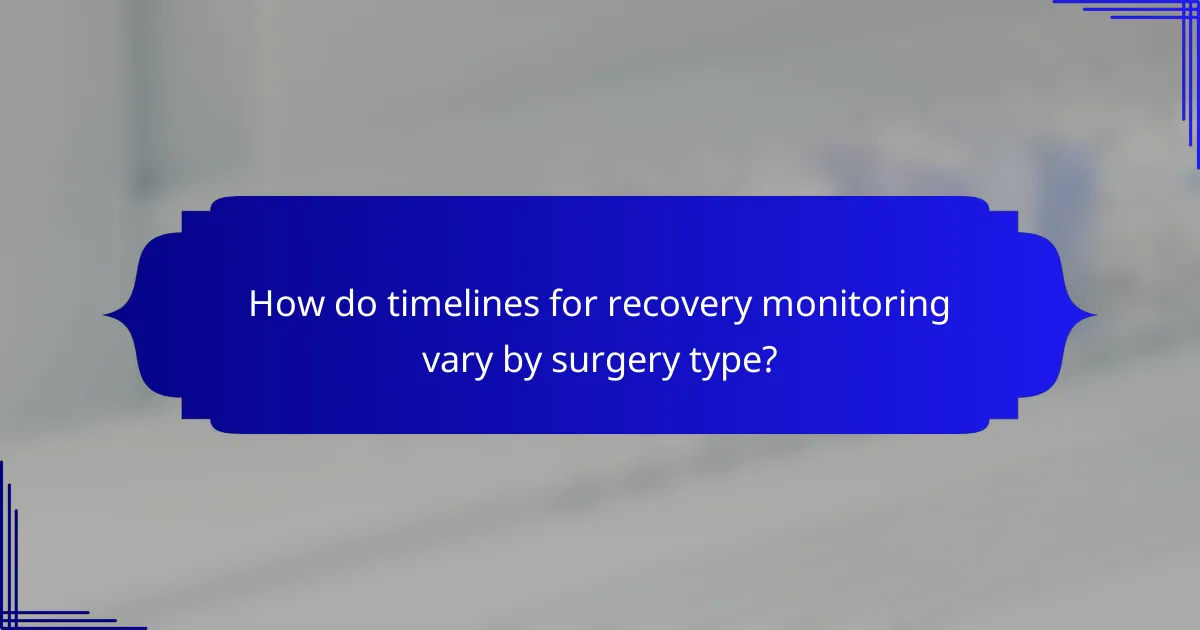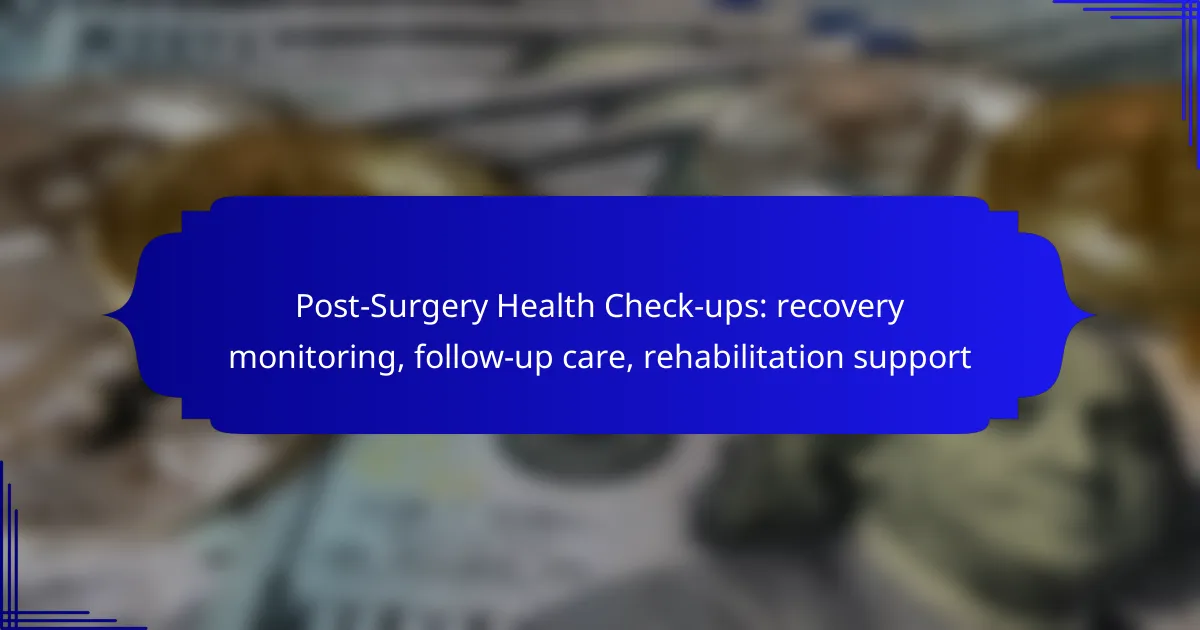Post-surgery health check-ups are crucial for ensuring a smooth recovery, as they encompass recovery monitoring, follow-up care, and rehabilitation support. By systematically tracking a patient’s progress, healthcare providers can make timely interventions and tailor treatment plans to enhance healing and manage pain effectively.

What are the best practices for post-surgery health check-ups in Australia?
In Australia, effective post-surgery health check-ups involve a systematic approach to recovery monitoring, follow-up care, and rehabilitation support. These practices ensure that patients heal properly, manage pain effectively, and adjust their rehabilitation plans as needed.
Regular follow-up appointments
Regular follow-up appointments are crucial for tracking recovery progress after surgery. These visits typically occur within a week to a month post-operation, depending on the procedure and individual recovery rates. During these appointments, healthcare providers assess the patient’s overall health and address any concerns.
Patients should keep a record of their symptoms and any changes they experience to discuss during these visits. This proactive approach helps in identifying potential complications early and facilitates timely interventions.
Monitoring vital signs
Monitoring vital signs is an essential component of post-surgery health check-ups. Key indicators such as heart rate, blood pressure, and temperature provide insights into the patient’s recovery status. Abnormal readings may signal complications that require immediate attention.
Patients are often advised to check their vital signs regularly at home, especially in the initial days after surgery. Keeping a log can help both patients and healthcare providers identify trends that might need further investigation.
Assessing surgical site healing
Assessing the healing of the surgical site is vital to ensure there are no signs of infection or complications. Healthcare providers typically examine the incision for redness, swelling, or discharge during follow-up appointments. Patients should also be vigilant about any unusual changes at the site.
Patients can support healing by following care instructions, such as keeping the area clean and dry. If any concerning symptoms arise, such as increased pain or fever, they should contact their healthcare provider promptly.
Evaluating pain management
Evaluating pain management is a critical aspect of post-surgery care. Patients should communicate their pain levels to their healthcare providers, who can adjust medications or suggest alternative therapies as needed. Effective pain control is essential for promoting mobility and overall recovery.
Patients should be aware of the types of pain relief available, including over-the-counter medications and prescribed opioids, and understand the importance of using them responsibly. Regularly assessing pain can help in tailoring a suitable pain management plan.
Adjusting rehabilitation plans
Adjusting rehabilitation plans based on recovery progress is vital for optimal healing. As patients recover, their physical capabilities may change, necessitating modifications to their rehabilitation exercises. Regular assessments help in tailoring these plans to individual needs.
Patients should actively participate in discussions about their rehabilitation goals and progress. This collaboration with healthcare providers ensures that the rehabilitation plan remains effective and aligned with the patient’s recovery journey.

How can recovery monitoring improve outcomes?
Recovery monitoring significantly enhances patient outcomes by facilitating timely interventions and personalized care. By closely tracking recovery progress, healthcare providers can identify issues early and adjust treatment plans accordingly.
Early detection of complications
Monitoring recovery allows for the early identification of complications such as infections, blood clots, or delayed healing. Regular check-ups can include assessments like vital sign monitoring and wound inspections, which help catch potential problems before they escalate.
For instance, if a patient reports increased pain or swelling, healthcare providers can investigate further, potentially preventing serious complications. This proactive approach can reduce hospital readmission rates and improve overall recovery times.
Enhanced patient engagement
Recovery monitoring fosters greater patient engagement by involving individuals in their healing process. When patients are informed about their recovery progress and encouraged to participate in follow-up care, they are more likely to adhere to treatment plans.
Healthcare providers can utilize tools such as mobile apps or telehealth consultations to keep patients informed and motivated. This engagement not only boosts compliance but also empowers patients to take an active role in their health.
Tailored recovery plans
Effective recovery monitoring enables the development of tailored recovery plans that cater to individual patient needs. By assessing progress and challenges, healthcare providers can customize rehabilitation strategies to optimize recovery.
For example, a patient recovering from knee surgery may require different physical therapy exercises based on their specific recovery trajectory. Adjusting these plans based on real-time data ensures that patients receive the most appropriate care for their unique situations.

What types of follow-up care are available after surgery?
After surgery, follow-up care is essential for monitoring recovery and ensuring proper healing. Options include in-person consultations, telehealth services, and home health visits, each providing unique benefits and considerations for post-operative patients.
In-person consultations
In-person consultations involve face-to-face meetings with healthcare providers to assess recovery progress. These visits allow for thorough physical examinations, direct communication about symptoms, and adjustments to treatment plans as needed.
Patients should schedule these appointments based on their surgeon’s recommendations, typically within a week or two after surgery. It’s crucial to prepare a list of questions or concerns to discuss during the visit to maximize the benefit of the consultation.
Telehealth services
Telehealth services offer a convenient alternative for follow-up care, allowing patients to connect with healthcare providers remotely. This option is particularly beneficial for those with mobility issues or those living in remote areas.
During a telehealth appointment, patients can discuss their recovery, report any complications, and receive guidance without the need to travel. Ensure that you have a stable internet connection and a quiet space for the consultation to facilitate effective communication.
Home health visits
Home health visits involve healthcare professionals coming to the patient’s home to provide care and monitor recovery. This service is especially useful for individuals who may have difficulty traveling due to pain or mobility restrictions.
Home health providers can assist with wound care, medication management, and rehabilitation exercises. Patients should check with their insurance plans to understand coverage options for home health services, as these can vary significantly.

What rehabilitation support options exist for post-surgery patients?
Post-surgery patients have various rehabilitation support options to aid their recovery. These options typically include physical therapy, occupational therapy, and support groups, which can significantly enhance healing and improve quality of life.
Physical therapy programs
Physical therapy programs are designed to restore movement and function after surgery. These programs often involve tailored exercises that focus on strength, flexibility, and balance, helping patients regain mobility and reduce pain.
Patients should consider the frequency and duration of therapy sessions, which can vary widely based on individual needs and the type of surgery. Typically, sessions may occur 1-3 times per week for several weeks to months, depending on recovery progress.
Occupational therapy services
Occupational therapy services assist patients in adapting to daily activities post-surgery. These services focus on improving skills necessary for everyday tasks, such as dressing, cooking, and returning to work.
Therapists may provide adaptive equipment or techniques to facilitate independence. Patients should discuss their specific goals with their occupational therapist to create a personalized plan that addresses their unique challenges and lifestyle needs.
Support groups in Australia
Support groups in Australia offer emotional and social support for post-surgery patients. These groups allow individuals to share experiences, challenges, and coping strategies, fostering a sense of community and understanding.
Many hospitals and community health organizations facilitate these groups, often focusing on specific surgeries or conditions. Patients can benefit from connecting with others who have undergone similar experiences, which can enhance motivation and emotional resilience during recovery.

What criteria should be considered when choosing a follow-up care provider?
When selecting a follow-up care provider, consider their experience with your specific surgery, the availability of specialized services, and patient reviews. These factors can significantly impact your recovery and overall satisfaction with the care you receive.
Provider experience with specific surgeries
It’s crucial to choose a provider who has substantial experience with the type of surgery you underwent. Look for specialists who regularly perform your specific procedure, as they are more likely to be familiar with potential complications and effective recovery strategies.
Ask about the number of similar surgeries they have conducted and their success rates. A provider with a strong track record can give you confidence in their ability to manage your post-operative care effectively.
Availability of specialized services
Ensure that your follow-up care provider offers specialized services that align with your recovery needs. This may include physical therapy, pain management, or nutritional counseling, which can enhance your rehabilitation process.
Check if the provider has access to advanced diagnostic tools or rehabilitation technologies that can aid in monitoring your recovery. These resources can lead to more personalized care and quicker recovery times.
Patient reviews and testimonials
Reading patient reviews and testimonials can provide insight into the quality of care offered by a follow-up provider. Look for feedback on their communication skills, responsiveness, and overall patient satisfaction.
Consider checking reputable healthcare review sites or asking for recommendations from your primary care physician. Positive testimonials from previous patients can help you feel more secure in your choice of provider.

How do timelines for recovery monitoring vary by surgery type?
Recovery monitoring timelines differ significantly based on the type of surgery performed. Each surgical procedure has its own recovery protocols, influencing how long follow-up care and rehabilitation support are needed.
Orthopedic surgery timelines
Orthopedic surgeries, such as joint replacements or fracture repairs, typically require a structured recovery timeline. Initial follow-up appointments often occur within a week or two post-surgery to assess healing and manage pain. Subsequent visits may be scheduled every few weeks for several months to monitor progress.
Rehabilitation support is crucial in orthopedic recovery. Patients usually start physical therapy within a few days after surgery, focusing on regaining mobility and strength. The duration of rehabilitation can range from a few weeks to several months, depending on the complexity of the surgery and individual healing rates.
To ensure optimal recovery, patients should adhere to their rehabilitation plan and attend all scheduled follow-up appointments. Common pitfalls include neglecting physical therapy exercises or skipping follow-up visits, which can hinder recovery progress.
